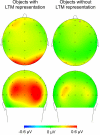Memory-matches evoke human gamma-responses
- PMID: 15084225
- PMCID: PMC419345
- DOI: 10.1186/1471-2202-5-13
Memory-matches evoke human gamma-responses
Abstract
Background: Human brain activity in the gamma frequency range has been shown to be a correlate of numerous cognitive functions like attention, perception and memory access. More specifically, gamma activity has been found to be enhanced when stimuli are stored in or match with short-term memory (STM). We tested the hypothesis that gamma activity is also evoked when stimuli match representations in long-term-memory (LTM). EEG was recorded from 13 subjects performing a choice reaction task. Visual stimuli were either known real-world objects with a memory representation or novel configurations never seen before.
Results: All stimuli evoked an early gamma response which was maximal over occipital electrodes. This evoked gamma activity was significantly larger for items that matched memory templates.
Conclusions: Therefore, we argue that gamma activity results from the feedback from memory into perception systems. This assumption seems to be true for STM as well as LTM.
Figures





References
-
- Müller MM, Bosch J, Elbert T, Kreiter A, Sosa MV, Sosa PV, Rockstroh B. Visually induced gamma-based responses in human electroencephalographic activity – a link to animal studies. Exp Brain Res. 1996;112:96–102. - PubMed
Publication types
MeSH terms
LinkOut - more resources
Full Text Sources
Medical

